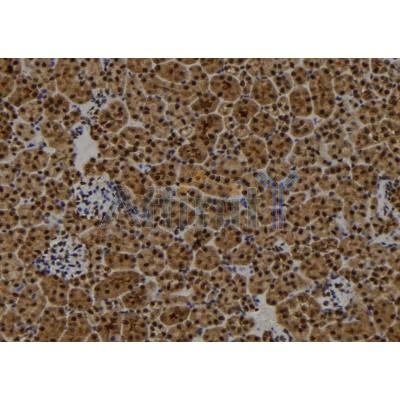RB1CC1 Antibody - #DF12022
| Product: | RB1CC1 Antibody |
| Catalog: | DF12022 |
| Description: | Rabbit polyclonal antibody to RB1CC1 |
| Application: | WB IHC |
| Reactivity: | Human, Mouse, Rat, Monkey |
| Prediction: | Bovine, Horse, Sheep, Rabbit, Dog |
| Mol.Wt.: | 200 kDa; 183kD(Calculated). |
| Uniprot: | Q8TDY2 |
| RRID: | AB_2844827 |
Related Downloads
Protocols
Product Info
*The optimal dilutions should be determined by the end user. For optimal experimental results, antibody reuse is not recommended.
*Tips:
WB: For western blot detection of denatured protein samples. IHC: For immunohistochemical detection of paraffin sections (IHC-p) or frozen sections (IHC-f) of tissue samples. IF/ICC: For immunofluorescence detection of cell samples. ELISA(peptide): For ELISA detection of antigenic peptide.
Cite Format: Affinity Biosciences Cat# DF12022, RRID:AB_2844827.
Fold/Unfold
FAK family kinase-interacting protein of 200 kDa; FIP200; RB1-inducible coiled-coil protein 1; RB1CC1; RBCC1_HUMAN;
Immunogens
A synthesized peptide derived from human RB1CC1, corresponding to a region within C-terminal amino acids.
Expression levels correlated closely with those of RB1 in cancer cell lines as well as in various normal human tissues. Abundantly expressed in human musculoskeletal and cultured osteosarcoma cells.
- Q8TDY2 RBCC1_HUMAN:
- Protein BLAST With
- NCBI/
- ExPASy/
- Uniprot
MKLYVFLVNTGTTLTFDTELTVQTVADLKHAIQSKYKIAIQHQVLVVNGGECMAADRRVCTYSAGTDTNPIFLFNKEMILCDRPPAIPKTTFSTENDMEIKVEESLMMPAVFHTVASRTQLALEMYEVAKKLCSFCEGLVHDEHLQHQGWAAIMANLEDCSNSYQKLLFKFESIYSNYLQSIEDIKLKLTHLGTAVSVMAKIPLLECLTRHSYRECLGRLDSLPEHEDSEKAEMKRSTELVLSPDMPRTTNESLLTSFPKSVEHVSPDTADAESGKEIRESCQSTVHQQDETTIDTKDGDLPFFNVSLLDWINVQDRPNDVESLVRKCFDSMSRLDPRIIRPFIAECRQTIAKLDNQNMKAIKGLEDRLYALDQMIASCGRLVNEQKELAQGFLANQKRAENLKDASVLPDLCLSHANQLMIMLQNHRKLLDIKQKCTTAKQELANNLHVRLKWCCFVMLHADQDGEKLQALLRLVIELLERVKIVEALSTVPQMYCLAVVEVVRRKMFIKHYREWAGALVKDGKRLYEAEKSKRESFGKLFRKSFLRNRLFRGLDSWPPSFCTQKPRKFDCELPDISLKDLQFLQSFCPSEVQPFLRVPLLCDFEPLHQHVLALHNLVKAAQSLDEMSQTITDLLSEQKASVSQTSPQSASSPRMESTAGITTTTSPRTPPPLTVQDPLCPAVCPLEELSPDSIDAHTFDFETIPHPNIEQTIHQVSLDLDSLAESPESDFMSAVNEFVIEENLSSPNPISDPQSPEMMVESLYSSVINAIDSRRMQDTNVCGKEDFGDHTSLNVQLERCRVVAQDSHFSIQTIKEDLCHFRTFVQKEQCDFSNSLKCTAVEIRNIIEKVKCSLEITLKEKHQKELLSLKNEYEGKLDGLIKETEENENKIKKLKGELVCLEEVLQNKDNEFALVKHEKEAVICLQNEKDQKLLEMENIMHSQNCEIKELKQSREIVLEDLKKLHVENDEKLQLLRAELQSLEQSHLKELEDTLQVRHIQEFEKVMTDHRVSLEELKKENQQIINQIQESHAEIIQEKEKQLQELKLKVSDLSDTRCKLEVELALKEAETDEIKILLEESRAQQKETLKSLLEQETENLRTEISKLNQKIQDNNENYQVGLAELRTLMTIEKDQCISELISRHEEESNILKAELNKVTSLHNQAFEIEKNLKEQIIELQSKLDSELSALERQKDEKITQQEEKYEAIIQNLEKDRQKLVSSQEQDREQLIQKLNCEKDEAIQTALKEFKLEREVVEKELLEKVKHLENQIAKSPAIDSTRGDSSSLVAELQEKLQEEKAKFLEQLEEQEKRKNEEMQNVRTSLIAEQQTNFNTVLTREKMRKENIINDLSDKLKSTMQQQERDKDLIESLSEDRARLLEEKKKLEEEVSKLRSSSFVPSPYVATAPELYGACAPELPGESDRSAVETADEGRVDSAMETSMMSVQENIHMLSEEKQRIMLLERTLQLKEEENKRLNQRLMSQSMSSVSSRHSEKIAIRDFQVGDLVLIILDERHDNYVLFTVSPTLYFLHSESLPALDLKPGEGASGASRRPWVLGKVMEKEYCQAKKAQNRFKVPLGTKFYRVKAVSWNKKV
Predictions
Score>80(red) has high confidence and is suggested to be used for WB detection. *The prediction model is mainly based on the alignment of immunogen sequences, the results are for reference only, not as the basis of quality assurance.
High(score>80) Medium(80>score>50) Low(score<50) No confidence
Research Backgrounds
Involved in autophagy. Regulates early events but also late events of autophagosome formation through direct interaction with Atg16L1. Required for the formation of the autophagosome-like double-membrane structure that surrounds the Salmonella-containing vacuole (SCV) during S.typhimurium infection and subsequent xenophagy (By similarity). Involved in repair of DNA damage caused by ionizing radiation, which subsequently improves cell survival by decreasing apoptosis (By similarity). Inhibits PTK2/FAK1 and PTK2B/PYK2 kinase activity, affecting their downstream signaling pathways. Plays a role as a modulator of TGF-beta-signaling by restricting substrate specificity of RNF111 (By similarity). Functions as a DNA-binding transcription factor. Is a potent regulator of the RB1 pathway through induction of RB1 expression. Plays a crucial role in muscular differentiation. Plays an indispensable role in fetal hematopoiesis and in the regulation of neuronal homeostasis (By similarity).
Nucleus. Cytoplasm. Cytoplasm>Cytosol. Preautophagosomal structure. Lysosome.
Note: Under starvation conditions, is localized to puncate structures primarily representing the isolation membrane that sequesters a portion of the cytoplasm resulting in the formation of an autophagosome.
Expression levels correlated closely with those of RB1 in cancer cell lines as well as in various normal human tissues. Abundantly expressed in human musculoskeletal and cultured osteosarcoma cells.
Belongs to the ATG17 family.
Research Fields
· Cellular Processes > Transport and catabolism > Autophagy - animal. (View pathway)
· Organismal Systems > Aging > Longevity regulating pathway. (View pathway)
Restrictive clause
Affinity Biosciences tests all products strictly. Citations are provided as a resource for additional applications that have not been validated by Affinity Biosciences. Please choose the appropriate format for each application and consult Materials and Methods sections for additional details about the use of any product in these publications.
For Research Use Only.
Not for use in diagnostic or therapeutic procedures. Not for resale. Not for distribution without written consent. Affinity Biosciences will not be held responsible for patent infringement or other violations that may occur with the use of our products. Affinity Biosciences, Affinity Biosciences Logo and all other trademarks are the property of Affinity Biosciences LTD.











